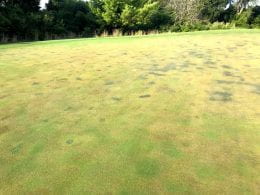
I’m not a marathoner, but I’ve heard those that do run marathons prepare not only through extensive training, but also by consuming the appropriate food for weeks before the race. Examples include fruits, vegetables, whole grains, lean proteins, and healthy fats. Fasting or an improper diet wouldn’t result in a good marathon, and would likely require someone to withdraw during the race.
Creeping bentgrass and annual bluegrass, cool-season grasses, are also participants in summer marathons in many parts of the world. They enjoy the cool climate in spring and autumn and prefer to prepare for the marathon during these seasons. Of course, grasses don’t rely on consumption of food, but they do create their own carbohydrates through photosynthesis. Plants take in carbon dioxide through stomates on leaves, which is used in combination with light and water in the photosynthetic process to manufacture carbohydrates that include glucose, sucrose, and fructose which promote plant growth and health. Carbohydrate storage is also a critical to finish the summer marathon.
If creeping bentgrass and annual bluegrass have met nutritional demands to sustain health and promote growth, they may then be able to store carbohydrates (fructan and starch) in crowns or stolons for use later in the season. This is critical for summer survival, as the ability to manufacture carbohydrates declines as temperatures rise. If nothing’s left in the refrigerator, and a runner can’t go shopping, that would also create pre-marathon issues. To maximize the ability of these grasses to store carbohydrates in preparation for the summer marathon, two things other than cool air temperatures are desired – leaf area and no seedheads (annual bluegrass).
Grasses on putting greens are mowed at heights that minimize leaf area. Years ago, one-eighth of an inch (0.125 inches; 3.2 mm) was considered very low. Now, it’s not unusual to hear from superintendents who may mow at heights lower than one-tenth of an inch (0.100 inches; 2.5 mm). Lower mowing heights increase green speed (ball roll), but keep in mind that whenever a portion of a leaf is removed, chlorophyll, which captures sunlight for photosynthesis, and stomates, the entry points for carbon dioxide, go away with that portion of the leaf, which reduces carbohydrate manufacturing capability. Leaf area is increased by mowing higher or less frequently. If either is done, speed can be enhanced by rolling rather than mowing, which allows the leaf area to remain. Many superintendents have incorporated rolling as a mechanism to enhance green speed and leaf area.
Cool-season grasses tolerate lower mowing heights better during spring and autumn months than in the summer. This has encouraged many superintendents to consider mowing lower during cooler months, and then raising the mowing height when summer stress occurs. However, keep in mind that the efficiency of carbohydrate production is greater during the cooler months than it is in the summer. As such, the potential to accumulate carbohydrates for the summer marathon is enhanced by allowing greater leaf area in spring and autumn.*
Annual bluegrass can be a prolific seedhead producer, even at very low mowing heights. Seedhead emergence tends to drop the level of carbohydrates in the plant, and can also reduce rooting. Suppressing annual bluegrass seedheads by using plant growth regulators can help annual bluegrass get through the summer marathon.
A pastor in Kansas City recently spoke about how he was training for several weeks prior to a marathon and was excited about it. He also considered that his diet at the time was critical, and adjusted it several weeks before the race. Once the marathon began and the physical demand had started, he asked himself “why am I doing this?”. He struggled through the first 10 miles of the marathon, but at the halfway point, his attitude improved, and the healthy food consumed prior to the marathon began to take effect. He finished the marathon with a smile (but hasn’t run another) and followed it with a beer – first attempt to get carbohydrate levels back up! Superintendents in areas where a summer marathon is on schedule should consider enhancing leaf area when creeping bentgrass and annual bluegrass are most efficient at fixing carbon. You may not see the putting greens smile at the end of the summer, but quality may likely be enhanced!
(Article appears in Golf Course Management magazine, April 2022; *Dr. Bingru Huang, Distinguished Professor at Rutgers University, has conducted extensive research on creeping bentgrass heat tolerance and has enhanced our knowledge in this area.)
